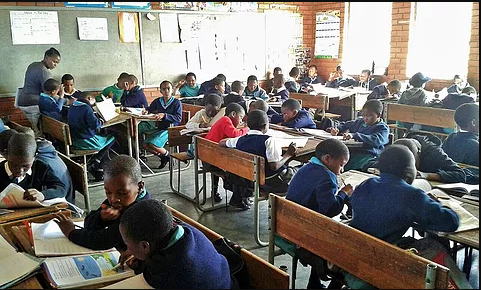03.16.17 A Postcard from a South African Classroom
Found this picture in a blog post by an organization that supports teachers in South Africa, Edupeg. It’s of a teacher named Ms. Shezi who teaches grade 4 at Bonisanani Primary in South Africa. I found it both informative and inspiring:

The blog described her class this way:
Ms. Shezi already has well established Entry and Exit routines which has made for smooth lesson transitions and co-operative learner behaviour. As a strong relationship already exists between Ms Shezi and her learners, techniques such as Strong Voice are sufficient for managing learner behaviour.
There’s a lot in that paragraph- the idea that when kids know what we want them to do, when they know how to do it and when those behaviors lead to success, then they are happy. Discipline–teaching students the right way to do something and just maybe making a habit of it- makes for more positive behavior and better relationships. The paragraph also gets at the idea that when that foundation is laid a little bit of redirection goes a long way. The purpose of Strong Voice is to be able to get kids back on track productively and directly- so that everyone keeps learning and, crucially, so that behavioral situations don’t get any worse and don’t have to lead to kids leaving the classroom or receiving sanctions. For a good teacher, as for Ms. Shezi, a bit of Strong Voice, supported by clear “this is how we do it” should be sufficient.
But even more telling is the caption to the picture:
Ms Shezi’s Grade 4 learners are busy with group and independent work while she circulates and does Affirmative Checking. Using Affirmative Checking means learners only start independent work once they show they’ve mastered the relevant skill.
And indeed the picture shows that. But it shows also hows Ms. Shezi’s scholars busily and productively at work when there appear to be almost 60 children in the room. For teachers here in the US, it’s a reminder- first, i suppose that we are fortunate to have the resources we do; second that as we like to say on the TLaC team, “little things have big muscles.” Mastery of small parts of effective technique can make for dramatic differences. You circulate more efficiently when students are working independently–you know what you are looking for (tracking not watching), you make student materials consistent and simple to review (standardize the format), you use affirmative checking to decide how you’ll react when students struggle or succeed- you do those little things and all of a sudden you can make even a very large class productive.
I note that because we often face class size challenges here int he US… and by that we mean 30+ kids in a classroom. But Ms. Shezi shows us that technique can even tip the scales in our favor at 60* students.
By the way the picture reminds me of one of a telling moment early in my career. Dave Levin had just founded his first KIPP school on the Bronx, and I was lucky enough to visit. Levin as many people know was a legendary teacher before he became a school leader. On the day i visited he was teaching a math class to 60 kids. Some of them were siting on the book shelves. Some on the floor. But every kid was engaged, focused and excited. Every kid was working hard. The lesson was incredible. Afterwards I asked Dave why he was teaching a class that large. “We just haven’t found the right math teacher yet,” he said, “and I’d rather teach it myself with 60 kids and know it’s right than have class size half as much but the teaching not good enough.”




